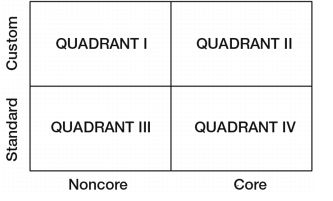A quadrant approach (see Figure 6.1) classifies all Postal Service purchases into four categories, depending on their impact on Postal Service core competencies (noncore versus core) and complexities (standard versus custom). The Quadrant approach should be used by the client and the life cycle management team to guide their disposal decision to trade in, donate, recycle, reallocate, resell, or remove.
Figure 6.1
Four Quadrants

Excess and unused items in this quadrant will be either recycled or reallocated. For the identified surplus that is to be recycled, the client and item manager must relocate this surplus to an appropriate scrap dealer. For reallocation, the client must redeploy and relocate this surplus to the new client. The strategic approach regarding Quadrant I calls for supply continuity, and these items should be used multiple times.
Excess items from Quadrant II play an integral role in the Postal Service’s operations and will be traded in, recycled, reallocated, or resold. For identified excess that is to be traded in, the item manager must contact the supplier, and because the transaction is contractual, the supplier will pay the Postal Service for the surplus that has been reacquired. For recycling, the client and item manager must relocate this surplus to an appropriate scrap dealer. For reallocation, the client must redeploy and relocate this surplus to the new client. For reselling, the market analyst must be consulted to determine the value of a specific product if it will be bought by an external party. The surplus will then be sold, and the client can determine how it will be physically relocated to the new owner.
Excess and surplus items in Quadrant III will be donated, recycled, reallocated, resold, or removed. These items have many sources and many options and provide low value to the end client. For identified items that are to be donated, the life cycle management team will determine who the recipients will be. For identified surplus that is to be recycled, the client and item manager must relocate this surplus to an appropriate scrap dealer. For reallocation, the client must redeploy and relocate this surplus to the new client. For identified surplus that will be resold, the market analyst must be consulted, the surplus will then be sold, and the client can determine how it will be physically relocated to the new owner. For identified surplus that is to be removed, the item manager must consult the CO (because supplier involvement is sometimes required) and then ensure that the items are disposed of or donated.
Excess items in Quadrant IV have created direct value for the client and are readily available in the marketplace. Items of this standard nature can have various functions, and are therefore useful both internally and externally. These items can be remarketed, donated, recycled, reallocated, or resold. For identified excess that is to be remarketed, the item manager must contact the supplier, and because the transaction is contractual, the supplier will pay the Postal Service for the surplus that has been reacquired. For donations, the client and life cycle management team will work together to determine which organization the materials will be donated to. For identified surplus that is to be recycled, the client and item manager must relocate this surplus to an appropriate scrap dealer. For identified surplus that is to be reallocated, the client must redeploy and relocate this surplus to the new client. For reselling, the market analyst must be consulted to determine the value of a specific product if it will be bought by an external party. The surplus will then be sold, and the client will determine how it will be physically relocated to the new owner.
